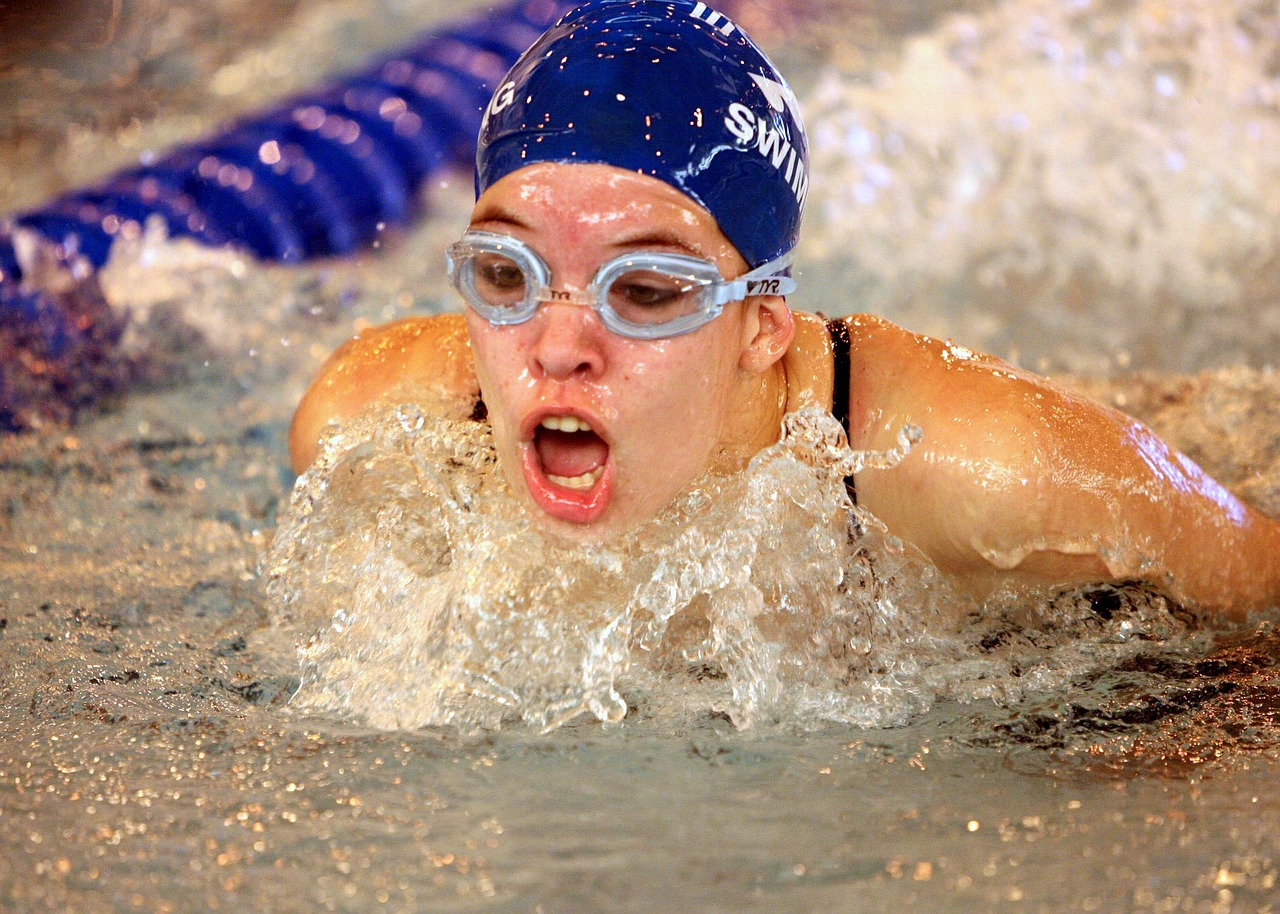ASL for swim: All you should know about (American Sign Language) ASL for Swim
American Sign Language (ASL) is a visual language, using precise hand shapes, facial expressions, and body movements to convey meaning.
It is a lifeline for millions of individuals with hearing damage, empowering them to engage in meaningful conversations and build connections.
While ASL (American Sign Language) has long been recognized as a valuable means of communication in society, its application in the water has gained interest in recent years.
Advertisements
The unique environment of swimming pools, beaches, and water-based activities demands a different mode of communication for individuals with hearing disability, one that transcends spoken words.

ASL bridges this gap, allowing swimmers of these disabilities to communicate effortlessly, share their experiences, and express their thoughts without barriers.
From basic gestures like “swim,” “dive,” and “float” to more complex signs for specific strokes, ASL offers a comprehensive sign language tailored to the swimming realm.
In this blog post, we’ll explore all you should know about (American Sign Language) ASL for swim, shedding light on its key signs.
Advertisements
Whether you’re a seasoned swimmer, a curious sign language enthusiast, or simply seeking to enhance your communication skills in the water with swimmers with communication disabilities, this article is for you.
The Importance of ASL for deaf or hard-of-hearing swimmers
Imagine a swimmer eagerly preparing for a race, surrounded by teammates and coaches who communicate seamlessly.
For deaf or hard-of-hearing individuals, this scenario can be overwhelming, as verbal communication may not be readily accessible.
However, by incorporating the American Sign Language (ASL), a whole new world of effective communication opens up.
ASL utilizes a visual medium, relying on hand gestures, facial expressions, and body movements to convey meaning.
By mastering ASL, swimmers can effortlessly participate in discussions, receive instructions, and engage with their peers and coaches, thus breaking communication barriers that might hinder their progress.
What is the (American Sign Language) ASL for Swim?
In American Sign Language (ASL), the sign for “swim” is a wonderful expression that truly captures the essence of the activity.
It involves simple movements that imitate the stylish motions of swimming. To learn how to make the sign for “swim” in ASL, just follow these simple steps:
Step 1: Extend both arms in front of your body, parallel to each other, with your palms facing down.
Step 2: Gently move your arms back and forth in a smooth, flowing manner, as if you’re gliding through water while swimming.
Step 3: As you move your arms, let your face relax and show a gentle smile that expresses the joy and liberation you feel while swimming.
Below is a video presentation that shows the practical sign of ASL for swim:
Remember, signing is not only about hand movements; facial expressions and body language are crucial elements that add depth and meaning to the signs.
How to Learn the American Sign Language (ASL) for Swimming Purpose
We’ll explore the importance of learning ASL for swim enthusiasts and professionals, as well as provide an overview of the learning process and available resources.
Importance of Learning ASL for Swim Enthusiasts and Professional
-
Inclusive Communication: Learning ASL allows you to communicate effectively with individuals who are deaf or hard of hearing.
By acquiring even basic ASL skills, you can create a welcoming and inclusive environment for all swimmers, ensuring they have equal access to instruction, guidance, and safety measures.
-
Safety Precautions: Swimming involves inherent risks, and prompt communication is essential in emergency situations.
By understanding ASL, you can quickly communicate important safety information to individuals who cannot hear vocal instructions.
This can prevent accidents, enable efficient response to emergencies, and ultimately save lives. -
Enhanced Teaching and Coaching: If you’re a swimming instructor or coach, knowing ASL can significantly enhance your ability to teach and train individuals with hearing disabilities.
By using ASL, you can provide clear instructions, demonstrations, and feedback, ensuring that every swimmer has the opportunity to fully comprehend and improve their skills.
ASL Learning Process for Swim Enthusiasts and Professionals
-
Start with ASL Basics: Begin your ASL learning journey by mastering the fundamentals. This includes learning the ASL alphabet, numbers, and common phrases related to swimming.
There are numerous online resources, videos, and mobile apps available that offer step-by-step tutorials and interactive exercises to help you grasp the basics. -
Enroll in ASL Classes: Consider enrolling in ASL classes specifically tailored for swimming enthusiasts or professionals.
These classes often focus on aquatic-related vocabulary, phrases, and scenarios, enabling you to communicate effectively within the swimming context.
Check with local community centers, schools, or organizations that specialize in ASL instruction for suitable classes. -
Practice Regularly: Consistency is key when it comes to mastering ASL. Regular practice helps reinforce your knowledge and improve your signing fluency.
Find opportunities to practice ASL within your swimming community, such as participating in inclusive swimming events, joining ASL conversation groups, or connecting with individuals who are deaf or hard of hearing. -
Seek Guidance from Experts: If you’re serious about becoming proficient in ASL for swimming, consider seeking guidance from ASL experts or consultants who have experience in the field of swimming.
They can provide specialized training, customized instruction, and invaluable insights to help you navigate the challenges of signing in a swimming context.
Resources Available for Learning ASL
-
Online Tutorials and Courses: Websites like Lifeprint (www.lifeprint.com) and Start ASL (www.startasl.com) offer comprehensive online tutorials, lessons, and courses specifically designed to teach ASL.
These resources cover a wide range of topics, including swimming related signs, and provide interactive exercises to enhance your learning experience. -
Mobile Apps: Take advantage of mobile apps such as “ASL Coach” and “SignSchool” which provide lessons, quizzes, and videos to learn ASL at your own pace.
These apps often include a dictionary of signs, allowing you to easily search for swimming related terms and practice signing accurately.
-
Local ASL Classes: Explore your local community centers, colleges, or organizations that offer ASL classes.
Look for courses that specifically cater to swimming enthusiasts or professionals.
Learning in a classroom setting can provide valuable opportunities for hands-on practice and interaction with instructors and fellow learners. -
Deaf Community Events: Attend deaf community events or gatherings to immerse yourself in a signing environment and connect with individuals who use ASL as their primary means of communication.
Engaging with the deaf community can help you develop a deeper understanding of the language, its cultural context, and provide real world practice opportunities.
READ ALSO: 14 Important Swim Meet Survival Kit you Need
The Benefits of Learning ASL for Swim Enthusiasts

We will explore the numerous benefits of learning ASL for swim enthusiasts and how it can enhance their overall swimming experience:
- Building Stronger Connections
ASL can play a crucial role in building stronger connections within the swimming community.
By learning ASL, swim enthusiasts can engage in meaningful conversations, share their experiences, and forge lasting friendships with both deaf and hearing individuals.
This bridge of communication promotes a sense of unity, acceptance, and understanding among diverse groups of people, fostering a more inclusive swimming environment for all.
- Increased Awareness and Advocacy
Learning ASL not only benefits individual swimmers but also contributes to raising awareness and advocacy for the deaf and hard-of-hearing community within the swimming world.
By embracing ASL, swim enthusiasts can help break down barriers and promote inclusivity in swimming facilities, events, and competitions.
They can become advocates for equal access, encouraging swim clubs, organizations, and governing bodies to prioritize communication accessibility for all participants.
By spreading awareness and championing inclusivity, swim enthusiasts can make a positive and lasting impact on the swimming community as a whole.
Communication Barriers Faced by ASL Users in Swim Environments
We will explore the unique obstacles faced by ASL users in swim environments and discuss strategies to break down these barriers, fostering inclusivity and understanding for all.
Below are Communication Barriers Faced by ASL Users in Swim Environments:
- Lack of ASL-Fluent Staff
One of the primary challenges encountered by ASL users in swim environments is the scarcity of staff who are fluent in ASL.
While lifeguards and swim instructors are trained to ensure safety and facilitate effective communication, the lack of ASL proficiency can limit their ability to effectively communicate with ASL users.
This gap can lead to misunderstandings, frustration, and potentially compromise safety.
- Limited Access to Information
Another barrier faced by ASL users in swim environments is the limited availability of information in ASL.
Important announcements, schedules, or safety guidelines are often communicated through written or spoken language, excluding those who rely on ASL as their primary mode of communication.
Strategies to Solve the Communication Barriers
-
To address lack of ASL-Fluent Staff, swim facilities should consider providing ASL training to their staff or hiring ASL interpreters.
By having ASL-fluent staff members or interpreters available, swim environments can enhance communication and ensure a safer and more inclusive experience for ASL users. -
To address the issue of limited access to Information by ASL swimmers, swim facilities can strive to provide information in multiple formats, including ASL videos or visual materials.
Websites and social media platforms should also be accessible and inclusive, featuring ASL-translated content, captions, and video descriptions.
By making information readily available in ASL, swim environments can ensure that ASL users have equal access to important details and updates.
READ ALSO: 10 Important Aquatic Skills You Need to Know
Inspirational Stories of Deaf Swimmers and the Power of ASL

We will share with you the inspiring journeys of deaf swimmers we’ve communicated with, who have defied the odds and achieved remarkable success, showcasing the unwavering power of American Sign Language in their swim journey:
- Sarah’s Story:
Sarah, a young deaf swimmer, faced many obstacles on her path to success. Born with hearing loss, she had to navigate a world designed primarily for those who could hear.
However, Sarah’s unwavering determination, coupled with her ability to communicate through ASL, allowed her to overcome these challenges.
With the support of her family, coaches, and teammates, Sarah went on to earn numerous accolades in different swimming competitions.
Her story serves as a testament to the power of ASL in fostering connection and enabling individuals to achieve their swim athletic dreams.
- Jake’s Journey:
Jake’s passion for swimming began at a young age, despite being born deaf. He discovered his love for the water and embraced the sport wholeheartedly.
However, the lack of communication accessibility posed significant challenges for Jake, until he discovered a swim center that uses ASL.
With the help of ASL interpreters and fellow swimmers who learned to communicate in sign language, Jake’s swimming career took off.
Conclusion
In conclusion, the American Sign Language (ASL) not only serves as a bridge between deaf swimmers and the hearing world but also fosters a sense of belonging and community among individuals with similar experiences.
Deaf swimmers often find solace and support in the deaf swimming community, where they can share their triumphs, challenges, and aspirations without the need for interpretation or adaptation.
ASL plays a vital role in creating an environment where all swimmers can thrive and achieve their goals, regardless of their hearing abilities.



